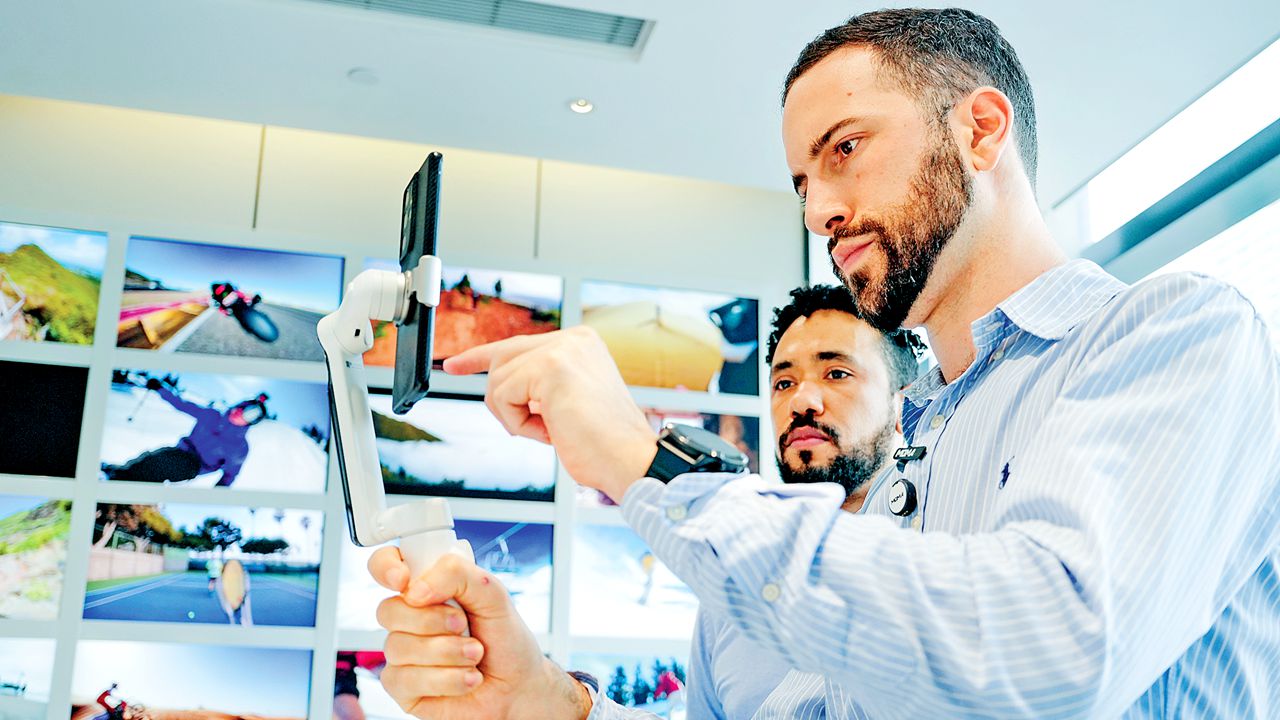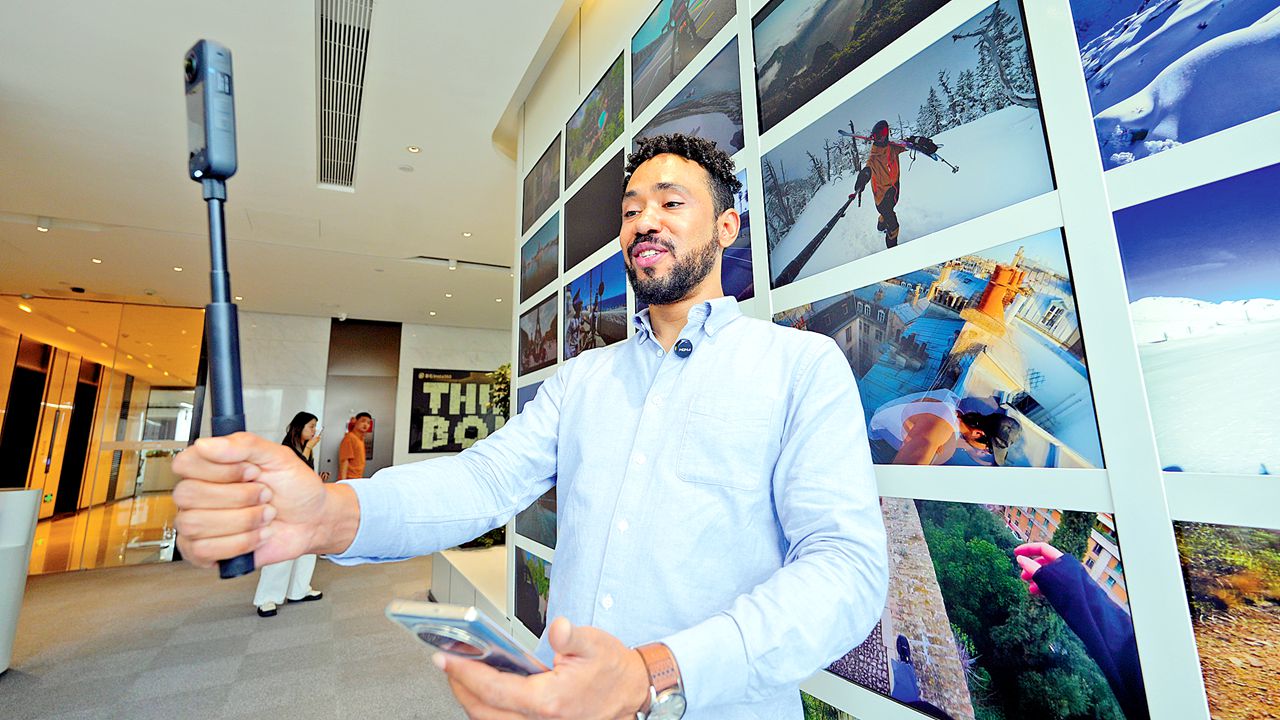Camera maker taps into sports industry opportunities
Writer: | Editor: Zhang Zhiqing | From: Shenzhen Daily | Updated: 2024-11-22
In 2015, when Liu Jingkang, Chen Yongqiang, and their team began developing panoramic cameras (360-degree VR cameras) in Shenzhen's Bao'an District, they could hardly imagine that their startup, Insta360, would evolve into a significant player in the sports industry.

Alex Garcia (front), head of partnerships at Insta360, introduces the Insta360 Flow, a portable stabilizer for smartphones, to Zach Mills, a U.S. copy editor with Shenzhen Daily and EyeShenzhen, at the company's office in Qianhai on April 3. Photos by Liu Xudong except otherwise stated
Since 2021, Insta360’s revenue has doubled year on year for two consecutive years, nearing 4 billion yuan (US$550 million) by 2023. By 2024, its market share of action cameras is poised to rival GoPro, a company that has led the field for over a decade.
When Insta360 entered the smart imaging hardware industry, its products had no direct connection to sports. The company’s breakthrough came from tapping into a rapidly growing, albeit niche, segment — sports videography.
Chen recalled that Insta360 initially aimed to meet the panoramic and VR filming needs of educational and conference livestreams.
In 2016, the company launched its first consumer-grade panoramic camera, the first in its class to capture and transform an instant panoramic image, winning the Consumer Electronics Show (CES) Innovation Award in 2017. However, from a commercial perspective, the product was less than successful.
“After the cameras were sold to distributors, they didn’t quickly reach consumers. Though initial sales hit 20 million yuan a month, they soon dropped to a few million yuan, mainly because consumers didn’t fully grasp the concept of panoramic cameras at that time,” Chen explained.

Zach Mills, a U.S. copy editor with Shenzhen Daily and EyeShenzhen, uses an Insta360 panoramic camera at the company's office in Qianhai on April 3.
In 2016, the global market for consumer-grade panoramic cameras was valued at just US$300 million to US$400 million. This led Chen and his colleagues to realize that, in order to grow, they needed to find a larger and differentiated market.
By 2017, videos of outdoor sports like skiing, cycling, and surfing were gaining traction on social media, and the number of Chinese participants in these sports was growing rapidly. Chen and his colleagues saw a clear demand for cameras capable of capturing and sharing these experiences.
The global action camera market was worth over US$1.4 billion at the time, but it was dominated by GoPro. Insta360 saw an opportunity. Rather than imitating GoPro, the company leveraged its panoramic imaging technology to fill gaps that GoPro had overlooked.
Traditional action cameras like GoPro required athletes to focus on framing shots while engaging in their sports, often causing them to miss key moments or compromise safety. Insta360’s panoramic imaging technology provided a solution by enabling users to capture footage first and frame it later. The company also perfected essential action camera features like image stabilization.

Employees of Insta360 are seen at work at the company's Qianhai office in this June 2 photo. Xinhua
“GoPro had already popularized the action camera among extreme sports fans,” said Liu.
Chen explained, “For example, the invisible selfie stick was achieved following our deep communication with skiing enthusiasts. In the past, when skiers needed to record their movements, the process was complex and expensive, often requiring an additional cameraman with heavy equipment. So we thought of making the selfie stick invisible, as it would allow 360-degree footage with the same effect as a follow-cam or drone shot without extra cost.”
This innovation is just one example of how Insta360, through direct feedback from users, continuously developed new features like smart data meters and “bullet time” effects. These features have since become popular on social media.

An Insta360 panoramic camera is seen being used by one of the Chinese athletes during the opening ceremony of the Paris Olympics on the Seine on July 26. Xinhua
Insta360 has reshaped how extreme sports enthusiasts capture video, transforming the creative process for adrenaline-driven athletes worldwide.
According to industry research by Frost & Sullivan, Chinese action camera brands are beginning to replace their Western counterparts due to greater innovation and closer alignment with consumer needs.
Other Chinese action camera manufacturers, such as DJI and AKASO, have also gained consumer approval in this field.
“As outdoor sports like skiing, cycling, and surfing gain popularity, especially in China in recent years, we are confident that both panoramic and action cameras will continue to thrive,” Chen concluded. (Xinhua)
Sports cinematography tips
For those new to filming sports or fast-paced action, getting started can be intimidating. These tips will help you capture better sports videos.

An Insta360 panoramic camera in operation.
Know the sport
Understanding the sport you’re filming is essential for capturing great footage. Familiarize yourself with player positions, movements, and scoring rules to anticipate key moments. If you’re new to the sport, attend a training session or two to grasp the fundamentals and plan your positioning during the game.
Know your gear
Mastering your camera is crucial, especially for one-time events like sports or weddings. Familiarize yourself with every button and menu so you can quickly adjust settings like frame rates or aperture instinctively. If you’re using rented equipment, get it a few days in advance to ensure you’re comfortable with its features and ready to capture every moment.
Get your settings right
Setting up your camera correctly is important, as different sports require different adjustments. Consider whether you’ll be shooting in slow motion (higher frame rates) or in varying lighting conditions (natural or stadium lights). Adjust your aperture to f/8 to f/11 for better focus on fast-moving players, and use a longer lens (70-200mm) to compress the image and keep the background sharp. For slower sports, you can use a wider aperture for more depth. Be prepared to make quick changes as needed to capture the action perfectly.
Preparation is key
Thorough preparation is essential for game day. Ensure all equipment is ready — batteries charged, gimbal balanced, and memory cards formatted. Check the weather if filming outdoors, and bring wet-weather protection just in case. Confirm the location and start time to avoid surprises, and arrive early to capture warm-ups, team huddles, and pre-game moments. When it comes to preparation, you can never be too thorough.
Look after yourself
Don’t overlook your own well-being. Protect yourself with sunblock or wet-weather gear as needed, and bring any support equipment you require. Take breaks when possible to rest and avoid strain. Remember, you can only do your best work if you take care of yourself first.